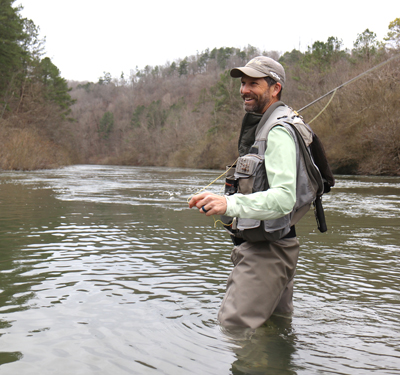All About Trout: Year-Round Trout Fishing On The Sipsey Fork

As fishermen wade into the cold, clear water of the Sipsey Fork, they’re reeling in a unique experience at Alabama’s only year-round rainbow trout fishery.
Outdoorsman Brandon Jackson said fishing the 12.5-mile tributary of the Black Warrior River is an adventure for fledgling fishermen and experienced anglers.
“Fish the Sipsey Fork for the experience,” said Jackson, eyeing the river as it cuts through steep, forested banks dividing Cullman and Walker counties. “It’s something you can’t get anywhere else in the state.”
Water in the Sipsey Fork is below 70 F year-round and is drawn from Smith Lake to generate power through two turbines at the base of a 300-foot-high dam. Alabama waterways are too warm for trout populations to occur naturally, so cold-loving trout have been stocked since 1974.
The Alabama Department of Conservation and Natural Resources (ADCNR) — through agreements with the U.S. Fish and Wildlife Service and Alabama Power Co. — stocks 3,000 trout monthly. The hatchery-raised fish usually range from 8 to 14 inches, though larger trout are occasionally stocked.
The current stocking rate exceeds requirements to sustain the fishery, with just 35% of trout being caught, ADCNR reports. ADCNR also stocks trout at public fishing lakes in Madison and Walker counties.
“The Sipsey Fork trout fishery is both economically and recreationally beneficial to Alabama,” said Chris McKee, ADCNR’s District III fisheries supervisor. “This fishery provides a unique angling opportunity for the public to catch a non-native species without traveling out of state.”
Light tackle is the only gear needed for trout fishing. Go-to bait includes spinners, small spoons, salmon eggs, corn or PowerBaits.
But most visitors fly-fish, replicating movements of trout’s go-to grub — insects. Whipping the rod and unfurling the line onto the water is ideal to snag rainbow trout, with its memorable dark back, pinkish streak and silver underside.
“You can fish another way for trout, but why would you?” quips Jackson, who owns the Riverside Fly Shop in Bremen and guides Sipsey Fork fishing trips.
During summer and fall, insects like grasshoppers, crickets, beetles and ants abound. Midges are present year-round, enticing anglers to use dry flies replicating the midge fly nymph.
“It’s the one thing trout eat every day,” Jackson said. “Using dry flies is the most fun way to fish because you see the fish come up, look at the fly and then eat it.”
The Sipsey Fork possession limit is five fish, though trout stamps aren’t needed, and there’s no size limit. Catch-and-release is encouraged, but culling is illegal.
Jackson’s ideal fishing experience includes cool temperatures at the beginning of season, with a threat of rain and gray cloud cover.
“It’s all about bugs,” he said. “That condition seems to keep bug life going better and hides you from the fish. Trout have great vision, and dark days make it harder for them to distinguish objects on the bank.”
ADCNR and partner agencies have enhanced in-stream fish habitat, improved angler access, and mimicked more natural stream conditions through a series of rock points, mid-channel boulders and in-stream woody structures. A year-round minimum flow improves water quality, lowers water temperature and increases trout survival.
Much Sipsey Fork trout fishing occurs above the Birmingham Water Works Pump Station. Farther downstream resembles meandering streams in south Appalachia and is nearly 100 feet wide with water flowing over pools and rapids. While most fly fishermen wade using insulated hip boots or waders, fishing by boat is necessary downstream of the Highway 69 bridge.
The Sipsey Fork doesn’t just allow for trout fishing; its water is used to generate electricity, so water levels can rise rapidly. A siren notifies the public when generation begins, and anglers should leave the stream and reach higher ground. The generation schedule is available at 1-800-LAKES-11 and can change without notice.
Despite juggling generation schedules and other environmental factors, Jackson said fly-fishing the Sipsey Fork is a joy.
“It’s all about learning a new skill, and even if you have fly-fished for warm water species, doing it for trout is different,” Jackson said. “It’s new and challenging and allows you to expand into something unique.”
Visit OutdoorAlabama.com to learn more about the Sipsey Fork.
